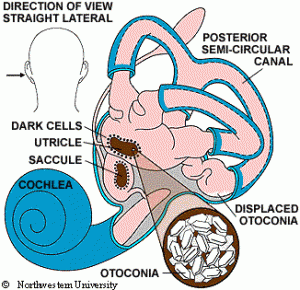At least 20% of vertigo patients have BPPV (benign paroxysmal positional vertigo). It is one of the most common causes of vertigo in the U.S.
BPPV is an abnormal sensation of motion. It is caused by changes in head position that alter head orientation in relation to gravity. These changes include:
- Lying down
- Looking up at a high shelf
- Getting in or out of bed
- Tipping your head up or down
- Sitting up from a lying position
- Turning over while sleeping
- Other quick head movements
Benign paroxysmal positional vertigo leads to short incidences of mild to severe dizziness (vertigo). Although in most cases, the condition is rarely serious.
You can break down BPPV this way:
- Benign – the underlying cause is not life-threatening
- Paroxysmal – random attacks occur and for brief spells
- Positional – caused by certain changes in head position
- Vertigo – The feeling as if you are moving or the world is moving around
The Causes of Benign Paroxysmal Positional Vertigo
Your inner ear contains tiny calcium “stones” (otoconia) that maintain body balance. In normal circumstances, a head movement should change the position of these fragments. You may experience an inflammation or infection. These complications can hinder the stones from moving as expected.
These calcium stones float in the fluid of the labyrinth. Once they get detached, they move around in the inner ear. They also move into one of the semicircular canals, where they are not supposed to be.
These canals are responsible for sensing head rotation. They depend on fluid movement to detect head movement. Unfortunately, if there are enough stones, they can form a clump and can move to the lower part of the inner ear. They can also enter one of the canals.
The movement of these stones results in an unwanted flow of fluid in the channel. This happens even after one stops moving the head. In the end, the brain believes that the head and body are moving, or the world is spinning. Fluid movement causes the nerve endings to send a message to the brain that the head is moving. And this happens even if the head is not moving. The brain gets confused and reacts with vertigo.
In most patients, there is no explanation behind the dislodging of the otoconia. But in most cases, BPPV is associated with a blow to the head.
More Causes
Other causes for benign paroxysmal positional vertigo may be:
- Ménières disease
- Head trauma
- Intensive aerobics
- Vestibular migraines
- Intubation (as a result of lying in bed for a prolonged time)
- Riding a bike on rough terrain
- Reduced blood flow
- Placing your head in the same position for a long time. For example, when you visit the dentist
- Inner ear infection
- Osteoporosis
- Labyrinthine conditions
Symptoms
BPPV lasts for a short while (usually a minute or two), and the main symptom is feeling as if you are spinning. The activities that cause the condition may vary, but the main ones are changes in head position.
Other symptoms and signs of Benign paroxysmal positional vertigo may include:
- Dizziness
- Vomiting
- Nausea
- Unsteadiness, or loss of balance
These symptoms are usually accompanied by nystagmus (abnormal rhythmic eye movements).
BPPV can be mild or severe and may lead to vomiting. And the symptoms can come and go. With each episode of benign paroxysmal positional vertigo, you may feel nauseated. But it is unlikely that you will feel sick (start to vomit). And while vertigo can last for just seconds, nausea can go on for up to an hour. In some cases, a patient may find it difficult to walk or stand without losing balance.
In most instances, the symptoms will vanish after weeks or months. Unfortunately, after the symptoms are long gone, some people may experience recurrences. And this may happen after months or years. Other individuals may have persistent symptoms for a long time.
The onset of BPPV may be scary for most patients. A tip or tilt of the head can cause extreme imbalance, vertigo, and patients may even lose balance and fall. The good news is that the symptoms lessen over a period of weeks to months.
Diagnosing Benign Paroxysmal Positional Vertigo
A physician should diagnose you through questions and physical examination. The Dix-Hallpike test is a standard procedure. It involves turning your head while a doctor watches your eyes. Doctors can also use the roll test.
It is important to note that there are two types of BPPV:
- Canalithiasis – loose crystals move about in the fluid. It is the most common
- Cupulolithiasis – crystals get stuck in the nerves that sense fluid movement. This type is rare. The stuck crystals make the nystagmus and vertigo to go on longer. To relieve it, the head needs to be in a ‘convenient’ position
Sometimes, the doctor may experience difficulty determining the cause of your symptoms. This may call for extra testing, such as:
- Magnetic resonance imaging (MRI)
- Electronystagmography (ENG) OR video nystagmography (VNG)
Most BPPV cases affect people who are 40 years or older. Younger people may still develop the condition. And it may result from an injury to the ear or infection. But when compared to men, women are the most affected.
BPPV Treament
Simple treatment methods involve moving the head in specific positions. These methods depend on gravity to move the tiny solid fragments. The two common methods are Epley and Semont maneuver.
Both treatments may fail to work. In some cases, the patient may not want to treat the condition. Benign paroxysmal positional vertigo usually disappears by itself. The period is usually over the course of days or weeks. This is because the brain gets accustomed to the ‘new’ signals.
Patients can perform various exercises that train the brain as an alternative. This will help the brain to familiarize with the signals.
Medication is not recommended. It may be beneficial if the patient is experiencing severe nausea and vomiting.
The downfall is that medicines can prolong benign paroxysmal positional vertigo.
The most common types of treatment include:
- The Epley maneuver – a series of head movements to ‘move’ otoconia fragments. Studies suggest that this method has an 80% cure rate
- Brandt-Daroff exercises – this qualifies if the Epley maneuver fails. It entails moving the head in different ways
- Surgery – surgery is rare and can only be undertaken if symptoms persist. Surgery is invasive and may lead to other complications.
- No treatment – BPPV patients discover precise head movements that trigger the condition. In the end, they instinctively avoid those positions or movements
A patient may also consider home remedies or changing his/her lifestyle. In 20-30% of patients, the symptoms occur again within the first week. Such patients will need treatment again. The most important thing to rememember is benign paroxysmal positional vertigo is treatable without medication, equipment, or surgery.


